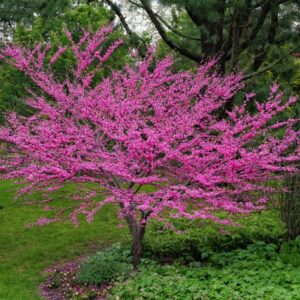Description
White Birch Tree (Betula papyrifera) 1 Yr Old
The White Birch Tree (Betula papyrifera) is a beautiful and hardy species native to North America. Famous for its signature white bark, slender form, and brilliant yellow fall color, it is an iconic tree often seen in forests, parks, and yards. White Birch thrives in a wide range of climates and is well-suited for a variety of landscapes, providing excellent aesthetic and ecological benefits.

1. Botanical Overview
- Scientific Name: Betula papyrifera
- Family: Betulaceae
- Growth Zones: Hardy in USDA zones 2–7
- Lifespan: Typically lives for 30-50 years, but can live longer in ideal conditions.
- Height and Spread: Grows to 40–70 feet tall with a spread of 25–50 feet.
2. Physical Characteristics
- Bark: The smooth, white bark peels in papery layers, making it easily identifiable and a standout in any landscape.
- Leaves: Triangular to oval-shaped with serrated edges, turning a bright yellow in the fall.
- Acorns: Small, lightweight, and wind-dispersed, providing food for wildlife such as squirrels and birds.
- Shape: The tree has a slender, graceful form with a narrow, upright canopy.
3. Habitat and Growing Conditions
- Soil: Prefers well-drained, slightly acidic soils but is adaptable to various soil types.
- Light: Thrives in full sun to partial shade.
- Watering: Tolerates moderate drought, but regular watering during dry periods encourages healthy growth.
- Native Range: Found across much of North America, particularly in northern forests, from Canada to parts of the northern U.S.
4. Ecological Impact
- Wildlife Benefits: Provides shelter and food for various species, including birds, insects, and small mammals.
- Pollination: The tree’s catkins provide nectar for pollinators, including bees.
- Soil Improvement: White Birch helps stabilize soil and prevent erosion, making it ideal for reforestation projects.
5. Uses and Benefits
- Ornamental Value: Known for its distinctive white bark and delicate foliage, the White Birch is a popular ornamental tree in gardens and public spaces.
- Shade Tree: Provides ample shade due to its broad canopy, making it an ideal choice for larger yards and parks.
- Timber: The wood is light and easy to work with, often used in paper production, furniture, and plywood.
- Ecological Contributions: Improves soil structure, supports biodiversity, and helps in water filtration.
6. Challenges and Considerations
- Shorter Lifespan: White Birch tends to have a shorter lifespan compared to other hardwood trees, often succumbing to diseases like birch dieback.
- Susceptibility to Pests: Vulnerable to aphids, birch borers, and leaf miners. Regular monitoring and care are recommended.
- Root System: Shallow roots can be prone to damage in compacted or dry soils, so regular watering and mulching are important.
7. Cultivation Tips
- Planting: Best planted in spring or fall when the tree is dormant. Ensure plenty of space for growth, as White Birch needs room to spread.
- Pruning: Prune in late winter or early spring before new growth begins to maintain shape and remove any dead or damaged branches.
- Mulching: Apply mulch around the base to retain moisture and improve soil health, especially in the tree’s first few years.
The White Birch Tree is a fantastic choice for those seeking an elegant, low-maintenance tree that offers seasonal beauty and benefits for wildlife and the ecosystem.







Reviews
There are no reviews yet.